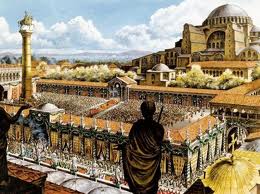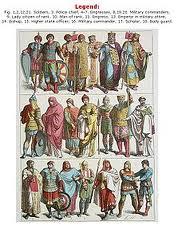|
The Byzantine Empire had a complex system of aristocracy and bureaucracy, which was inherited from the Roman Empire. At the apex of the pyramid stood the Emperor, sole ruler (autokrator) and divinely ordained, but beneath him a multitude of officials and court functionaries operated the administrative machinery of the Byzantine state.
The Byzantine political system bore unusual resemblance to the earlier patterns in China. The emperor was held to be ordained by God, head of church as well as state. He appointed church bishops and passed religious and secular laws. The elaborate court rituals symbolized the ideals of a divinely inspired, all-powerful ruler, though they also often immobilized rulers and inhibited innovative policy. At key points women held the imperial throne, while maintaining the ceremonial power of the office.

The Byzantium Empire bureaucracy differed from the Roman Empire in that the Roman Empire did not have a fiscal system, a state postal service or a secret police. They also collected money from the 10 percent tariff on trade and from the monopolies, while the Roman Empire did not have a budget. The Byzantium bureaucracy had skilled diplomats, which kept the enemies divided and used bribes, tributes and subsides, the Roman Empire used a basic administration without a professional civil service.

The Byzantine bureaucracy was run mostly by the emperor, who also controlled justice, with the aid of a civil service. The government had a fiscal system, a state postal service and a secrete army. It collected a 10 percent tax from the trade and more money from state monopolies. The Eunuchs filled the most important positions in the government.
In terms of staff numbers the Byzantine bureaucracy was relatively small: a recent estimate for the ninth century central civil service places the number of core staff at five to six hundred men, split between thirteen different bureaux or departments of state.

The most important distinction within the civil administration was made between Kritai, or judicial officers, and Sekretikoi, or financial officers. The Sekretikoi were overseen, in formal terms at least, by a general controller known as the Sakellarios. Chief amongst the Sekretikoi were departmental directors known by the general term Logothete (literally "Accountant").
The Logothetes tou Genikou, for example, was a finance minister in charge of raising taxes and accounting for revenue from state enterprises, whilst the Logothetes tou Stratiotikou had overall responsibility for army pay and general supplies. In political terms though, the most important departmental head was the Logothetes tou Dromou.
|

![]()


